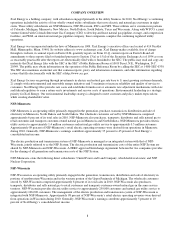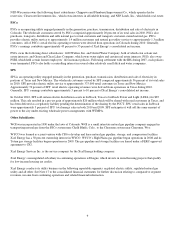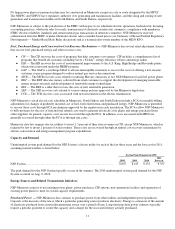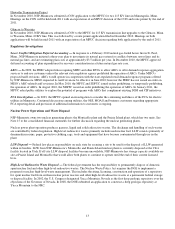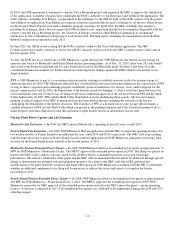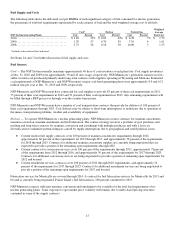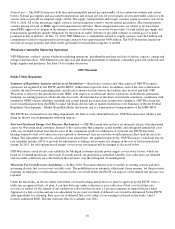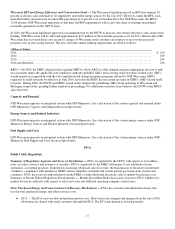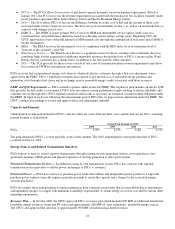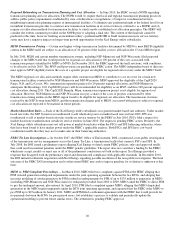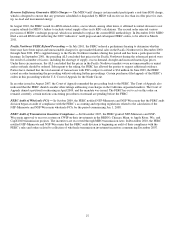Xcel Energy 2010 Annual Report Download - page 27
Download and view the complete annual report
Please find page 27 of the 2010 Xcel Energy annual report below. You can navigate through the pages in the report by either clicking on the pages listed below, or by using the keyword search tool below to find specific information within the annual report.
17
Wisconsin RPS and Energy Efficiency and Conservation Goals — The Wisconsin legislature passed an RPS that requires 10
percent of electric sales statewide to be supplied by renewable energy sources by the year 2015. However, under the RPS, each
individual utility must increase its renewable percentage by 6 percent over its baseline level. For NSP-Wisconsin, the RPS is
12.89 percent. NSP-Wisconsin anticipates it will meet the RPS requirements with its pro-rata share of existing and planned
renewable generation on the NSP System.
In 2010, the Wisconsin legislature approved a recommendation by the PSCW to increase state energy efficiency and conservation
funding. NSP-Wisconsin will be allocated approximately $9.6 million of the statewide program costs for 2011. Historically, NSP-
Wisconsin has recovered these costs in rates it charges to Wisconsin retail customers and expects to recover the increased
program costs in rates going forward. The new statewide annual funding requirements are fixed as follows:
(Millions of Dollars)
2011 .......................................................................................................... $120
2012 .......................................................................................................... 160
2013 .......................................................................................................... 204
2014 and thereafter ............................................................................................ 256
ARCs — In 2009, the FERC adopted rules requiring MISO to allow ARCs to offer demand response aggregation services to end-
use customers unless the applicable state regulatory authority prohibits ARCs from serving retail customers in their state. ARCs
would operate in competition with the state-regulated retail demand response programs offered by NSP-Wisconsin. MISO
requested its tariff revisions be effective in June 2010; however the FERC has not issued an order on MISO’s ARC-related tariff
revisions. During 2009, the PSCW and MPSC issued orders temporarily prohibiting ARCs from operating in Wisconsin and
Michigan, respectively, pending further regulatory proceedings. No additional action has been taken by the PSCW or the MPSC
since that time.
Capacity and Demand
NSP-Wisconsin operates an integrated system with NSP-Minnesota. See a discussion of the system capacity and demand under
NSP-Minnesota Capacity and Demand discussed previously.
Energy Sources and Related Initiatives
NSP-Wisconsin operates an integrated system with NSP-Minnesota. See a discussion of the system energy sources under NSP-
Minnesota Energy Sources and Related Initiatives discussed previously.
Fuel Supply and Costs
NSP-Wisconsin operates an integrated system with NSP-Minnesota. See a discussion of the system energy sources under NSP-
Minnesota Fuel Supply and Costs discussed previously.
PSCo
Public Utility Regulation
Summary of Regulatory Agencies and Areas of Jurisdiction — PSCo is regulated by the CPUC with respect to its facilities,
rates, accounts, services and issuance of securities. PSCo is regulated by the FERC with respect to its wholesale electric
operations, accounting practices, hydroelectric licensing, wholesale sales for resale, the transmission of electricity in interstate
commerce, compliance with mandatory NERC electric reliability standards and certain natural gas transactions in interstate
commerce. PSCo has received authorization from the FERC to make wholesale electricity sales at market-based prices (see
Summary of Recent Federal Regulatory Developments — Market-Based Rate Rules discussion); however, PSCo withdrew its
market-based rate authority with respect to sales in its own and affiliated operating company control areas.
Fuel, Purchased Energy and Conservation Cost-Recovery Mechanisms — PSCo has several retail adjustment clauses that
recover fuel, purchased energy and other resource costs:
● ECA — The ECA recovers fuel and purchase power costs. Short-term sales margins and margins from the sale of SO2
allowances are shared with retail customers through the ECA. The ECA mechanism is revised quarterly.



